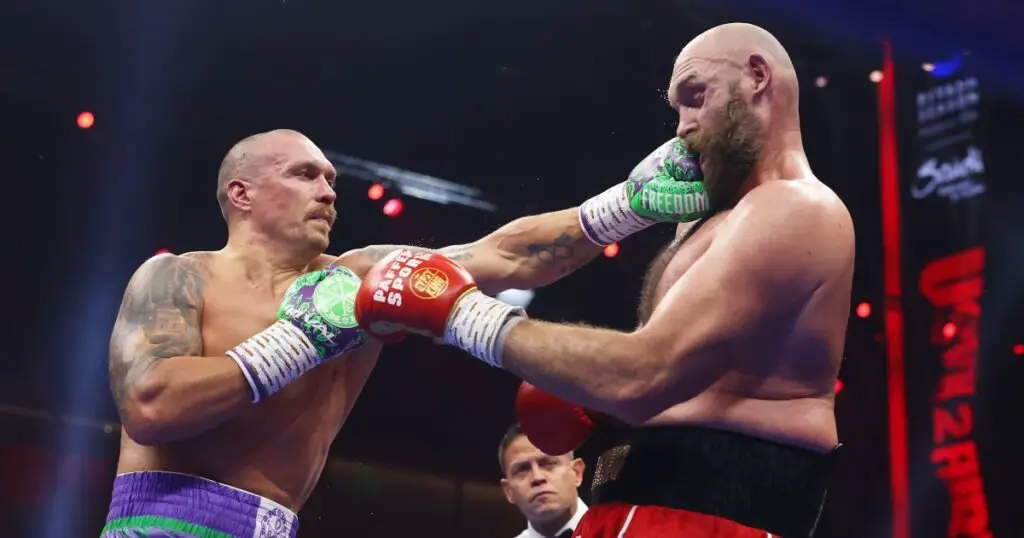An estimated 40,000 boxing fans watched Oleksandr Usyk defeat Tyson Fury at the Kingdom Arena in Riyadh earlier this month.
Millions tuned in to legal and illegal streams around the world to watch Usyk defend his title against Fury in a thrilling fight that reportedly netted the boxers a total of $191 million in prize money.
Earlier this year, an estimated 60 million households watched the exchange between aging boxing legend Mike Tyson and YouTube star Jake Paul. This was in addition to the 72,000 people at the arena in Texas, who, according to organizers, collectively paid a whopping $18.1 million to watch the fight in person.
Boxing: It’s a knockout
In 2024, the extraordinary number of exposures, online searches and viewership across all viewing platforms confirmed boxing’s status as one of the most popular and followed sports in the world.
But given the brutality, should boxing even be considered a sport?
While other sports work hard to better protect participants, especially from concussion injuries, boxing encourages just the opposite: inflict as much damage as possible on your opponent, which can result in a submission or a knockout, all while doing so Intention. celebrated and praised with fame and financial rewards.
“Compared to other contact sports, boxing is known to have the highest rate of concussions,” said Dr. Ejaz Shamim, neurosurgeon and chairman of the Mid-Atlantic Kaiser Permanente Research Institute, told Al Jazeera.
“A concussion occurs when the brain jolts back and forth and hits the inside of the skull. This causes brain damage and occurs every time a boxer is hit in the head. Any jarring event resembles a traumatic brain injury (TBI). Every traumatic brain injury results in irreversible brain damage.
“It is believed that in boxing alone, a concussion occurs approximately every 12.5 minutes of fight time. The head protection doesn’t help much with the concussion. The internal trauma to the brain occurs every time a boxer is hit in the head, with or without external head protection.”
According to the Manuel Velazquez Collection, which documents boxing deaths, an average of 13 boxers are killed in the ring each year. A separate investigation by the Association of Ringside Physicians found that there were at least 339 deaths between 1950 and 2007, with the percentage “higher in lower weight classes.”
The surreal sight of a 58-year-old Tyson back in the ring thrilled millions of his fans. But should the popularity, fame and revenue that the sport brings free it from the risks and threats? And which one outweighs the other?
“People may come to boxing to vent their anger and frustration, but they quickly learn that these things have little or no place in the gym or in the ring,” said Philip O’Connor, a sports journalist.
“Very, very few have what it takes to get into the ring and compete with another human being, using a limited set of rules where the goal is to knock out the opponent or at least injure them more as himself.
“After a lifetime of watching boxing and various martial arts and training more than my share, I can say that in my view the mental and physical benefits far outweigh the risks, but we must always strive to improve safety and eliminate or reduce risks to the greatest extent possible.”

Nothing amateurish about boxing injuries
Studies show that up to 20 percent of boxers suffer a concussion during their career, although many go unreported, especially in amateur boxing.
The 2020 Tokyo Olympics, where boxing is classified as an amateur sport, saw the highest number of injuries, according to the British Journal of Sports Medicine (BJSM). It placed second behind BMX at the 2016 Olympics in Rio de Janeiro. Overall, it ranks fifth on the list of Olympic sports with the highest injury rates.
According to the American Association of Neurological Surgeons, 90 percent of boxers suffer a traumatic brain injury during their career. Alzheimer’s Research and Therapy reported that former boxers remain more susceptible to natural brain aging and brain diseases.
While the World Boxing Federation (WBF) and the International Boxing Federation (IBF) did not respond to Al Jazeera’s questions about the brutality of the sport and the safety aspects, the International Olympic Committee (IOC) said that “the best was offered to the athletes and spectators.” “The safest possible conditions are a top priority for the IOC and the entire Olympic movement,” adding that “Olympic-style boxing does not have knockouts as its goal, nor does knockouts have one Have a point advantage.”
A WBF spokesman previously stated that “boxing does so much good for young people, keeping them off the streets and away from drugs, teaching them discipline and self-confidence and that the good far outweighs the bad.”

The popularity of boxing
Given the history of the sport, the number of participants worldwide and the financial situation, it is unlikely that boxing will cease to exist as a sport.
In the United States alone, the number of boxing athletes reached about 6.7 million in 2021, according to market research firm Statista, which added that the market size of the global boxing equipment industry was over $1.6 billion in the same year.
The World Boxing Council (WBC)’s total revenue from 2011 to 2020 was more than $32 million.
Forbes reported that professional boxer Floyd Mayweather Jr. pocketed $275 million from his fight against MMA boxer Conor McGregor in 2017, with the latter taking home about $100 million, the largest single payout in the history of the sport Sports.
“In terms of global media popularity, boxing is the fifth most popular sport in the world and the most popular combat sport in 2024,” said Kamilla Swart-Arries, an associate professor at Hamad Bin Khalifa University in Qatar.
“It has attracted legendary figures who have transcended their sport to become global cultural icons. Many boxers achieve international fame. Combined with its icons and role models, boxing also has low barriers to entry, is easily accessible and promotes community building by making boxing gyms an integral part of communities where youth can vent and exercise as an alternative to social ills.”

The way forward
So instead of banning boxing, can improved safety protocols, stricter regulations and banning certain practices make the sport safer?
“Over the years, boxing has undergone significant safety improvements to improve fighter protection and reduce the risk of serious injury. While the nature of the sport carries a high level of risk, these advancements aim to create a safer environment for fighters and minimize the likelihood of serious injury and death,” Swart-Arries added.
“I don’t think boxing should be abandoned as there are many other sports that are also considered dangerous. All of these sports will continue to generate global interest and appeal so that they are not abandoned. Therefore, it is important that they continually make improvements to make them safer.”
According to another study published by the BJSM, there are approximately six to eight injuries per 1,000 rounds of boxing. According to the BJSM study, about 10 to 20 percent of boxing injuries are serious or potentially life-threatening.
O’Connor, who is also a martial arts coach, says: “One dying boxer is one boxer too many,” adding that the sport “still has a long way to go in terms of fighter safety.”
“Boxing has always been with us in some form and will always be with us. The aim should be to ensure a fair, transparent and safe process that ensures the physical well-being of the participants. Any change should be considered and implemented to preserve the integrity of the sport.”
Head injuries, including concussions, cerebral hemorrhages and skull fractures, are the most common and serious injuries in boxing. Other injuries include cuts, broken noses and eye damage, highlighting the brutality of the sport.
While research is still ongoing, some studies suggest that up to 50 percent of former professional boxers may show signs of chronic traumatic encephalopathy – a chronic degenerative brain disease – after their careers are over.
“Preventing a concussion is very important to prevent the development of permanent brain damage in the future,” said Shamim, the neurosurgeon. “Every concussion has an additive effect and with every concussion the risk of further concussions increases.
“One-on-one fighting as a spectator sport like boxing has been around for thousands of years and is unlikely to ever disappear. However, boxing carries a high risk of concussions and traumatic brain injuries. There is always a risk of concussion and other trauma in martial arts.”





